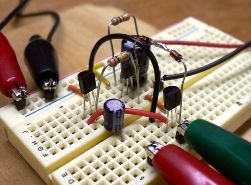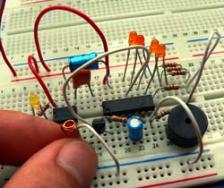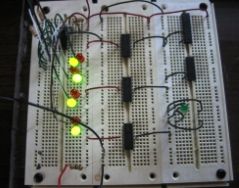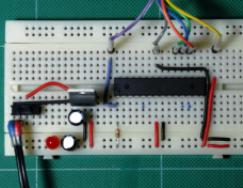Categories: Featured Articles » Practical Electronics
Number of views: 24049
Comments on the article: 0
Useful Tips for Using Solderless Development Boards
 Continuation of the article about solderless breadboards. If the first part of the article focuses on the review of prototyping boards and a description of their device, then now we will consider some useful subtleties and nuances that you need to know when working with such prototyping boards.
Continuation of the article about solderless breadboards. If the first part of the article focuses on the review of prototyping boards and a description of their device, then now we will consider some useful subtleties and nuances that you need to know when working with such prototyping boards.
If the instructions of the solderless breadboard say that the diameter of the wire inserted into the contacts is 0.4 - 0.7 mm, then you should not try to insert the conclusions of parts that are thicker than the specified value. This will lead to weakening and wear of the contacts. If the need arises for the use of such parts, it is better to solder the wires of the specified diameter to the thick terminals, or simply wrap them. Naturally, the wire should be without insulation.
Solderless breadboards are sold in two trim levels: with wires - jumpers and without them. In the first version, the board is somewhat more expensive, but it doesn’t matter at all if you manage to buy a separate board - you can always adapt something.
 Switching wires, of course, are sold separately, but if there is no desire or opportunity to buy them, then the wire SWRW 4 * 0.4, used for installation fire alarm.
Switching wires, of course, are sold separately, but if there is no desire or opportunity to buy them, then the wire SWRW 4 * 0.4, used for installation fire alarm.
Such a wire contains 4 insulated conductors with a diameter of just 0.4 mm. The insulation from the wire is easily removed with side cutters or a knife, and the cores themselves do not have a varnish coating.
If it is necessary to prototype a complex device, its individual functionally completed parts are best assembled on separate prototype boards of small sizes, and then assemble the entire structure from the resulting nodes.
Sometimes it happens that one device has not yet been assembled, but for some reason it is urgently necessary to assemble another, completely new one. And here it begins! It is necessary to disassemble the assembled, not yet debugged scheme, which then may need to be assembled again. But the only irreplaceable resource is the time that is wasted on these meaningless assemblies - disassemblies. Therefore, it is better not to skimp, but to purchase several prototyping boards, things will go faster.
 We should not forget that prototyping boards are designed for low-current equipment, - transistors and microcircuits. Therefore, in no case should it be supplied to them with a network voltage of 220 V. This can lead to overheating of the contacts and a breakdown of insulation, and what will happen to everyone after that, probably, is known.
We should not forget that prototyping boards are designed for low-current equipment, - transistors and microcircuits. Therefore, in no case should it be supplied to them with a network voltage of 220 V. This can lead to overheating of the contacts and a breakdown of insulation, and what will happen to everyone after that, probably, is known.
But even in transistors and microcircuits, a short circuit can occur, which will cause overheating of these elements, lead to heating of the contacts and melting of the plastic base of the board. Therefore, when you turn on the circuit for the first time, it is advisable to measure the current consumption, or at least control the temperature of all the elements with your finger.
General rule, not only for breadboards. First, components not affected by static electricity are installed: capacitors, resistors, diodes and zener diodes.
In addition to the parts, connecting wires are also installed on the breadboard. Connecting wires are best installed with tweezers or small pliers. With the same tools, conduct and dismantle the wires.
As in all such cases, check the board for proper installation, for short circuits or non-contacts. Unused microcircuit pins should not be left hanging in the air, but should be connected either to a common wire or to the power bus. Free inputs will lead to the appearance at the outputs of such elements simply simply interference that will spread throughout the circuit and its adjustment will become much more problematic.
 Probably, it will be necessary to note here that prototyping boards have a large mounting capacity due to long connecting wires, as well as many contacts. Therefore, too high-frequency circuits on such boards will work poorly, or maybe not at all.
Probably, it will be necessary to note here that prototyping boards have a large mounting capacity due to long connecting wires, as well as many contacts. Therefore, too high-frequency circuits on such boards will work poorly, or maybe not at all.
To avoid the influence of long conductors, it is advisable to power the microcircuit pins with small capacitors of ceramic capacitors, as is done on printed circuit boards.
Checking the correct installation, you can use the "oak" TTL chips, which are practically insensitive to static. You can, of course, do without them, but it’s not very convenient to push the multimeter probes into the holes on the board, it’s more convenient to touch the legs of the chips. After checking and eliminating inaccuracies, the “training” microcircuits should be replaced with real ones.
When using microcircuits of the CMOS structure for protection against statics, the use of antistatic grounding bracelets is very desirable. If these are not available, then we can recommend the use of wire washcloths for washing pans. Such a washcloth has the shape of a ring where you can stick your hand. Using a flexible wire through a resistor with a resistance of not more than 1MΩ, connect to ground.
After checking the circuit, you can insert the mentioned CMOS chips into the board. When setting up the circuit, replacing parts, or making changes, it is better not to remove the protective antistatic wristband.
Boris Aladyshkin
See also at bgv.electricianexp.com
:
